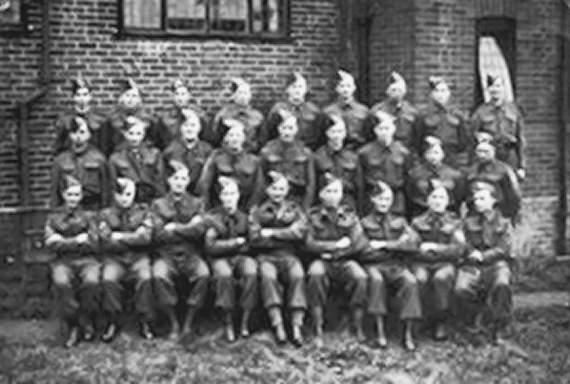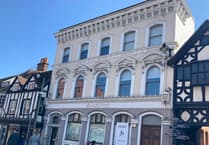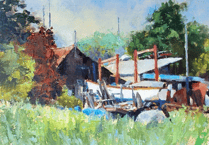While the legend of the Home Guard is synonymous with the tales from the Second World War hilariously recounted by Dad’s Army, the unit charged with defending the coastline of England started life as the Local Defence Volunteers (LDV).
The clarion call went out via the BBC over the airwaves and through provincial newspapers such as The Herald during May 1940 as the Germans advanced on the British Expeditionary Force, based in Normandy.
Following the evacuation of Dunkirk, which cost the lives of some 11,000 troops and another 40,000 who were captured, Churchill’s wartime cabinet became increasingly concerned by the hour of the real threat of invasion by the Nazis.
The comic inspiration of Dad’s Army’s creators Jimmy Perry and David Croft has been well documented and even in the early days of the LDV, wise cracks referred to elderly military men who answered Sir Anthony Eden’s call broadcast after the BBC News at 9pm on May 14, 1940, as the “Look, Duck and Vanish” brigade or the “Last Ditch Venture”.
Within minutes of that appeal going out, police stations were besieged by men wishing to sign up. One man arrived at Haslemere police station before Eden had finished speaking and queues quickly formed with men arriving right up until midnight.
From 6am the next morning The Herald reported men arriving in cars – often with “private chaffeurs” – to sign up, including one well-known retired solictior. Professions included retired officers, a dental surgeon, a chemist, an insurance secretary, an engineer, a schoolmaster, a forester, gardeners, grooms, farm workers, and labourers.
At one point police officers ran out of forms and there were still plenty of men in the queue come Thursday morning. Just 48 hours after the broadcast, some 250 men had signed up in Haslemere, under the command of Mr Clare Robinson, from Chiddingfold, who was appointed section leader. Similar scenes were reported in Farnham, while in the surrounding villages meetings were held over the next 10 days to form LDVs in the more rural parts of East Hampshire.
Longmoor was obviously a hive of military activity with the regular Army stationed at the camp served by the military railway. But the local civilian population in Bordon and Whitehill were still quick to sign up for the new LDV.
The Herald reported that under the direction of Superintendent McCallum, from Petersfield, several “local male aliens” were rounded up in the morning of Sunday, May 12, and the job was completed by noon.
“Police were also very busy on Wednesday as police Sergeant Pullman was kept busily employed in enrolling volunteers for the new Defence Corps,” the report continued.
“PS Pullman retained his customary cheery smile, however, as if refuting Gilbert’s dictum that a policeman’s lot is not a happy one.
The Herald wrote: “Parashots (as they were being described) are getting busy and are preparing a warm welcome for any possible visitors from Naziland.”
Within 24 hours, some 250,000 men and boys too young to join up were signed up nationally – Whitehall wanted 500,000 volunteers, but by the end of June the LDV was nearly one-and-a-half million strong.
The MP for Petersfield, General George Jeffreys, who was returned to Parliament after a by-election in 1941, was also put in charge of the Home Guard in Hampshire.
The future Baron Jeffreys had served in the Grenadier Guards during the First World War and fought in the Sudan and the second Boer War before heading the county’s Territorial Army, which was initially responsible for the LDVs, after a four-year spell in India.
He was responsible for identifying the Captain Mainwarings across the county to command the swiftly formed companies - all based around the existing police districts – who were constantly on the lookout for any sign of Nazi spies or paratroopers that could signal the beginning of the feared invasion.
Camberley, close to the Sandhurst military college were General Jeffreys had been educated, had more colonels per square mile than anywhere else in the country and had no shortage of willing leaders. But in more rural areas, finding men of the right background and experience to knock the recruits into shape proved much harder.
Each company consisted of roughly 1,600 men and was broken down into four platoons of around 400 personnel, which then formed into divisions of around 100 men – much larger than the cast portrayed protecting Walmington-on-Sea, obviously because of the needs of a 30-minute comedy show.
Recruits in the real Home Guard were supposed to be aged over 17 and under 65 years old, although exceptions were made – just as in the TV series – with boys as young as 14 serving and men many older than 70 found in the ranks.
And the dangers – real and imagined – of the bureaucracy of wartime logistics and shortages and the petty empire building of different arms of the Civil Defence organisations certainly rings true from first-hand accounts, The Herald can reveal.
Ronald Hack was a member of the Wrecclesham LDV. He said: “Our first muster was some seven to 10 days after the call and guard was then mounted at Abbots Motor Works, north east of the village.
“Our intrusion into the offices was resented and while we would continue to make our guard at the works, we had to find other quarters. A guardroom was eventually established in the firm’s canteen. At least we had light, water and metered gas, although the use of their coal in the heating stove was a sore point. We also had bed boards and straw-filled paliasses with a blanket each. This was to remain our guardroom until near the end, while the unit’s headquarters had to be established elsewhere.”
While some of the old soldiers who had seen action in the First World War – not like Sudan veteran Corporal Jones and his tales of combat with the “Fuzzy Wuzzies” – were keen to get to grips with the Hun again, the LDV had four distinct duties:
n To observe and repot any information of importance to Civil Defence or the military authorities in their area, such as an enemy attack or infiltration;
n To delay and obstruct the advancing enemy for as long as possible;
n To protect vital points such as factories, railways, telephone exchanges or reservoirs; and
n To act as guides for the regular Army.
The idea of a permanent watch was the buzzword rather than a fighting unit to tackle invading troops or parachutists, even if there were plenty happy to practice bayoneting the enemy. Local knowledge and the ability for the LDV to liaise with the Army – presumably through GHQ – meant their eyes and ears were considered more important than any stranger in the district, whether friend or foe.
The shouted warning of “Halt! Who goes there?” made famous by Corporal Jones reflected the long hours Home Guard soldiers spent manning checkpoints at night, as well as guarding the strategic targets mentioned above.
Woe betide anyone who failed to stop at an LDV checkpoint. If found without the requisite ID cards at roadblocks, they could expect to be hauled off to the nearest police station.
One Surrey man was fined £17 in court for “defying the authorities” after failing to properly identify himself. One patrol even found a boy who had escaped from Borstal.
Fears of Nazi spies remained for months and in May 25, 1940, The Herald’s leader warned: “Useful plans are being formulated for the defence work, but it would not be wise at the present time to mention them in detail. We have no wish to help any stray Fifth Columnists who might be lurking in the neighbourhood.”
Such paranoia, real or imagined, spawned a plethora of common catchphrases – careless talk costs lives; be like dad, keep mum; loose lips sink ships; and walls have ears. many of the best moments in Dad’s Army featured the clash between Captain Mainwaring and ARP warden Hodges, who called his opposite number Napoleon.
The LDV worked alongside Civil Defence teams to ensure the blackout was strictly observed, although it was the police who had the powers to prosecute offenders.
The Southern Railway and the Post Office saw the greatest activity in Surrey in the early days of the LDV, given the need to protect the vital communications networks.
In Liphook, The Herald reported on May 25, 1940, a meeting in the village hall for the “purpose of forming an LDV attracted a crowded and enthusiastic audience”.
Major General H Rowan-Robinson explained the scheme and “many men were enrolled”, and Mr Clare Robinson, from Chiddingfold, headed the Haslemere section.
The Farnham GPO was a hive of activity and The Herald advertised on June 8, 1940: Monday (8pm-9pm) General talk and guard duty; Tuesday (7pm-9pm) Miniature rifle range; Wednesday (8pm-9pm) Recruits drill; Thursday (8pm-9pm) Musketry; Friday (8pm-9pm) General duties and musketry; Daily (9.30pm) Mount guard.
Roy Montgomery grew up in a bungalow just outside Alton, having been born in November 1939. His father, Scott, joined the 24th Hampshire Home Guard’s A Company.
Alton was served by three platoons, with the headquarters in the town centre and number one and number two platoons covering east and west Alton respectively.
Sergeant Montgomery was the officer in charge of 2 Company with Jim May as his second in command. Two of the senior ranks among A Company were taken by Colonel Bird, who lived at the Old Farm House on Wellhouse Road, and Major Twinning.
A family notebook records Andrew May, Jim’s brother, as one of the sergeants and other soldiers Lee Wilson, A Risbridger, D Emery, A and J Butler, Mr Hodgson, and Mr Churchill!
Activities included range practice, wearing the LDV armbands, and the Beech section (No 2 Platoon) being sent to guard the waterworks at the observation point.





Comments
This article has no comments yet. Be the first to leave a comment.